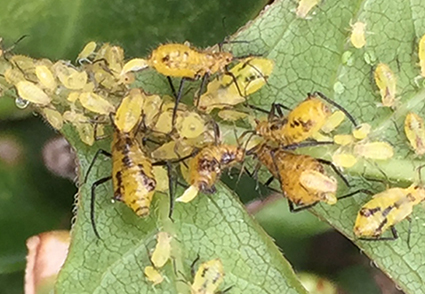Abstract
Based on integrative taxonomic practices by incorporating morphological, genetic, and ecological data, two new aphid species, Periphyllus blackmani Li & Huang sp. nov. and Periphyllus guangxuei Li & Huang sp. nov., are proposed from the known species P. koelreuteriae. Apterous and alate viviparous females of the new species are described and differences with their most similar species P. koelreuteriae are presented. These aphids of P. koelreuteriae species complex feed exclusively on Koelreuteria (Sapindaceae), a native tree group and commonly cultivated as ornamental plants in China. A key to the Chinese species of P. koelreuteriae species complex is provided.
References
Acevedo-Rodríguez, P., Van Welzen, P.C., Adema, F. & Van Der Ham, R.W.J.M. (2010) Sapindaceae. In: K. K, ed. The families and genera of vascular plants, vol. 10, Flowering plants, Eudicots: Sapindales, Cucurbitales, Myrtaceae. Springer-Verlag Heidelberg, Berlin, Germany, pp. 357–407. https://doi.org/10.1007/978-3-642-14397-7_17
Blackman, R.L. & Eastop, V.F. (2006) Aphids on the world's herbaceous plants and shrubs. John Wiley & Sons.
Blackman, R.L. & Eastop, V.F. (2020) Aphids on the World’s Plants: An online identification and information guide. Available from: http://www. aphidsonworldsplants. info/ (accessed 20 March 2021)
Favret, C. (2021) Aphid Species File. Version 5.0/5.0. Available from: http://Aphid.SpeciesFile.org (accessed 20 March 2021)
Foottit, R.G., Maw, H.E., Von Dohlen, C.D. & Hebert, P.D. (2008) Species identification of aphids (Insecta: Hemiptera: Aphididae) through DNA barcodes. Molecular Ecology Resources, 8 (6), 1189–1201. https://doi.org/10.1111/j.1755-0998.2008.02297.x
Hall, T.A. (1999) BioEdit: a user-friendly biological sequence alignment editor and analysis program for Windows 95/98/NT. In: Nucleic Acids Symposium Series. Information Retrieval Ltd., London, pp. 95–98.
Junkiert, Ł. & Wieczorek K. (2019) Description of the previously unknown morphs of Periphyllus koelreuteriae (Takahashi) (Hemiptera, Aphididae: Chaitophorinae). Zootaxa, 4585 (1), 360–368. https://doi.org/10.11646/zootaxa.4585.2.9
Kazutaka, K. & Standley, D.M. (2013) MAFFT Multiple Sequence Alignment Software Version 7: Improvements in Performance and Usability. Molecular Biology & Evolution, 30 (4), 772–780. https://doi.org/10.1093/molbev/mst010
Lange, H., Økland, B. & Krokene, P. (2006) Thresholds in the life cycle of the spruce bark beetle under climate change. Interjournal for Complex Systems, 1648 (2006), 1–10.
Li, Q., Deng, J., Chen, C., Zeng, L.D., Lin, X.L., Cheng, Z.T., Qiao, G.X. & Huang, X.L. (2020) DNA Barcoding Subtropical Aphids and Implications for Population Differentiation. Insects, 11, 11. https://doi.org/10.3390/insects11010011
Li, Q., Lin, X.L., Li, J.J., Liu, B. & Huang, X.L. (2021) Differentiation in the eastern Asian Periphyllus koelreuteriae (Hemiptera: Aphididae) species complex driven by climate and host plant. Biological Journal of the Linnean Society, 132 (3), 509–520. https://doi.org/10.1093/biolinnean/blaa206
Liu, Y.C., Lin, Y.C. & Kuo, M.H. (1999) Effect of temperature on development and reproduction by normal form and aestivating form of Periphyllus koelreuteriae (Takahashi). Plant Protection Bulletin, 41, 241–254. [in Chinese]
Qiao, G.X., Zhang, G.X. & Zhong, T.S. (2005) Fauna Sinica Insecta. Vol. 41 Homoptera Drepanosiphidae. Science Press, Beijing. [in Chinese]
Sosa-Pivatto, M., Camps, G.A., Baranzelli, M.C., Espíndola, A., Sérsic, A.N. & Cosacov, A. (2020) Connection, isolation and reconnection: Quaternary climatic oscillations and the Andes shaped the phylogeographical patterns of the Patagonian bee Centris cineraria (Apidae). Biological Journal of the Linnean Society, 131 (2), 396–416. https://doi.org/10.1093/biolinnean/blaa116
Stamatakis, A. (2014) RAxML version 8: a tool for phylogenetic analysis and post-analysis of large phylogenies. Bioinformatics, 30 (9), 1312–1313. https://doi.org/10.1093/bioinformatics/btu033
Sutherst, R.W. & Yonow, T. (1998) The geographical distribution of the Queensland fruit fly, Bactrocera (Dacus) tryoni, in relation to climate. Australian Journal of Agricultural Research, 49 (6), 935–954. https://doi.org/10.1071/A97152
Takahashi, R. (1919a) Studies on Chaitophorinella I–III. Zoological Magazine, 31 (370, 371 & 372), 245–247, 273–278 & 323–329. [in Japanese]
Takahashi, R. (1919b) Notes on some Japanese Aphididae. Proceedings of the Entomological Society of Washington, 21, 173–176.
Wang, N.C., Li, Z.H., Liu, G.L., Ye, B.H. & Dong, J.X. (1991) Study on the morphological characteristics and the variation of natural populations of Periphyllus Koelreuteriae. Journal of Shandong Agricultural University, 22 (1), 79–85. [in Chinese]
Wang, Q., Manchester, S.R., Gregor, H.J., Shen, S. & Li, Z.Y. (2013) Fruits of Koelreuteria (Sapindaceae) from the Cenozoic throughout the northern hemisphere: their ecological, evolutionary, and biogeographic implications. American Journal of Botany, 100 (2), 422–449. https://doi.org/10.3732/ajb.1200415
Wu, Z.Y., Sun, H., Zhou, Z.K., Peng, H. & Li, D.Z. (2007) Origin and differentiation of endemism in the flora of China. Frontiers of Biology in China, 2 (2), 125–143. https://doi.org/10.1007/s11515-007-0020-8
Xia, N.H. & Luo, X.Y. (1995) Geographical distribution of Sapindaceae in China. Journal of Tropical and Subtropical Botany, 3 (1), 13–28. [in Chinese]


